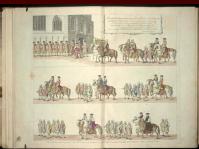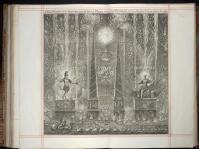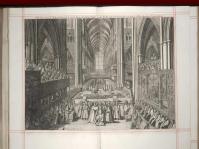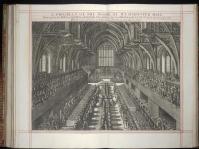The purpose of festival books
Through a Festival book it is sometimes possible to take in at a glance a complete event, giving the reader a view of the occasion more comprehensive and more detailed than any mere spectators could have gained even when they actually witnessed the entry.
Festival books were, moreover, designed in part to allow the principal actors the opportunity to experience again an important occasion in their lives, and to understand more fully the meaning of the symbols that had been laid on the surface of monuments. The books also served as memorials to noble participants who could recall in later life the splendour of past deeds, like the Lord Great Chamberlain’s appearance at the head of the great line of officials who led James II at the opening of Parliament in 1685.
Illustration 5 shows, in colour, the Lord Chamberlain’s 1685 procession to Parliament.

Illustration 5
The Lord Chamberlain was in charge of all royal ceremonial, and it was he who masterminded the same king’s coronation two years later. One can gauge the nature of the complex arrangements required from this view of the moment of crowning at Westminster.
You can see in Illustration 6 the vast spaces of the Abbey, faithfully rendered by the artist, with the scaffolds erected for spectators, the whole composition projecting an extraordinary calm and sense of order.
The same qualities are found in a static vision of the banquet which followed the coronation, given in Westminster Hall.
The engraving (Illustration 7) shows the diners at long tables, as well as spectators who had paid entrance money to see them eat. One can admire, too, the careful delineation of the handsome beams of this old ceremonial place.
A final image from this event illustrates well the kind of aspirations that creators of festivals struggled to project for even the weakest of monarchs.
In this firework display over the Thames (Illustration 8), James is shown as the Sun King (perhaps rivalling the status of Louis XIV) with, opposite him, the figure of a Roman knight bearing the king’s laurel crown.

Illustration 8
These are undoubtedly images of power and authority. They are, however, expressed in flames which were quickly to fade, and which disappeared altogether through the ineptitude of this sensuous, pleasure-seeking monarch. As William Cavendish, Duke of Newcastle, wrote to James’s predecessor: "For what preserves you kings more than ceremony?" Certainly, we know of the ambitious hopes which were never fulfilled, though eloquently projected in this record of the festival.


